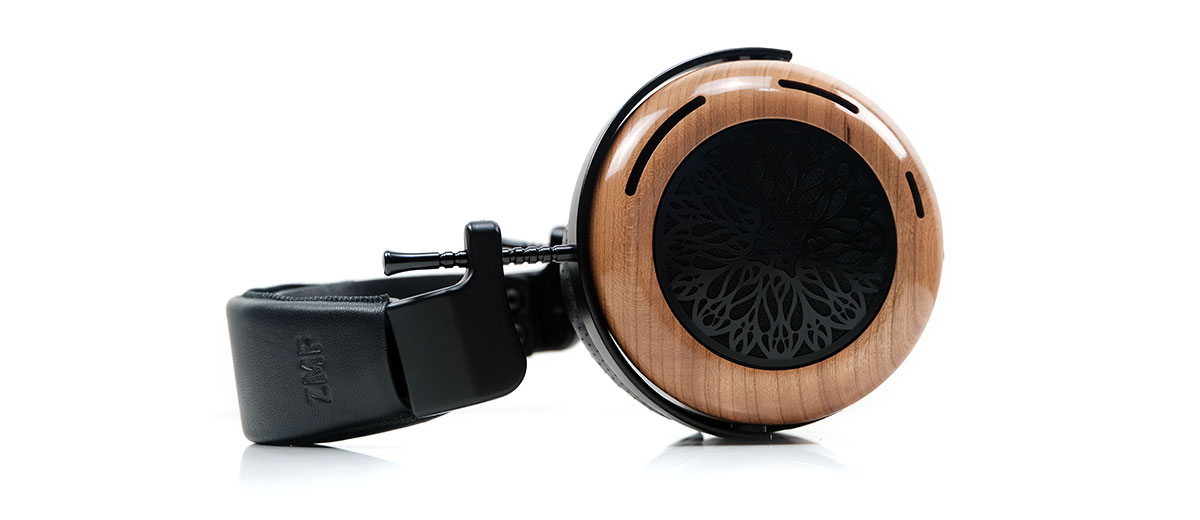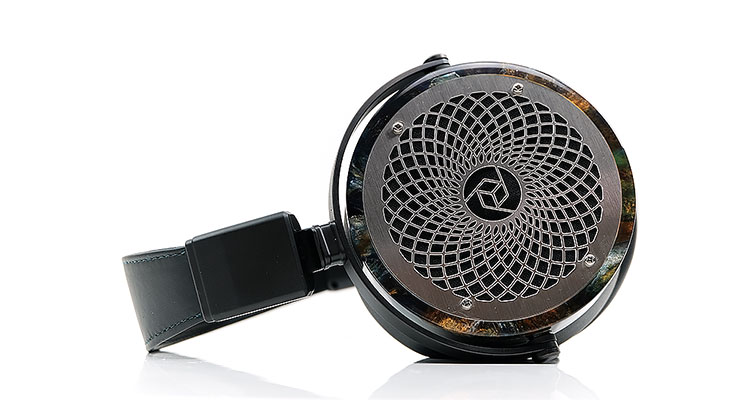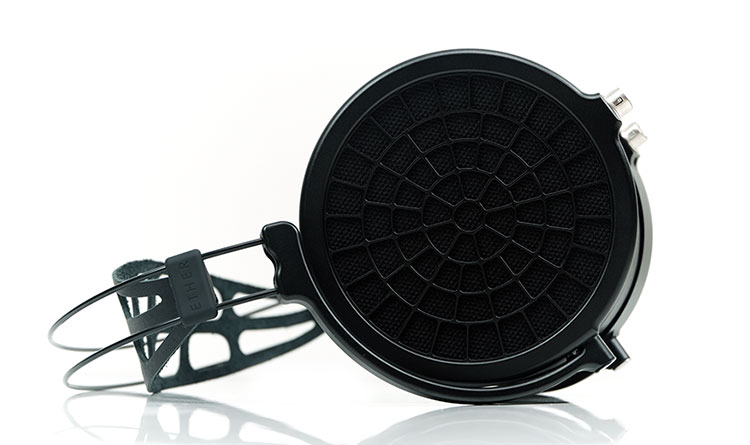Select Comparisons
All comparisons were completed using a Holo Audio Spring 2 DAC and a mix of the Feliks Audio Envy and the Cayin HA-300 MKII amplifiers. The Atrium tested was in stock with the universe pads and solid mesh attached.
Rosson Audio Design RAD-0
The RAD-0 is the debut full-sized open-back planar magnetic headphone from ex-Audeze CEO, Alexander Rosson. We reviewed and awarded the RAD-0 back in 2019.
$2600
Technical
The most fundamental difference between these two open-back circumaural flagship headphones is the driver implementation.
The RAD-0 uses a 66mm planar magnetic driver design with a proprietary array of 11 N52 magnets in a dual-sided configuration. The Atrium is also N52 magnetized but with a 50mm bio-cellulose dynamic driver which generally provides quite a different sonic property to planar.
Rosson Audio does not go into a whole lot of other detail on the internals beyond the driver and magnet design so it seems quite fixed as a stock single product design.
For example, in terms of internal meshing, we only know it has a solid cloth-like circular fabric for damping over the baffle from opening it up but there are no variations in that mesh either solid or vented, as you can get for the Atrium. Some have taken this back fabric out and reported some enhancements in the low-end performance so the RAD-O is definitely tweakable.
Unsurprisingly for planar versus dynamic the efficiency ratings are quite different with the RAD-0 coming in at 29Ω compared to the Atrium’s heavier 300Ω but a little more efficient at 98dB compared to 96dB. Of the two, the Atrium will sound louder at lower volumes.
If you have an impedance adjustable amplifier such as the Feliks Audio Envy or the Cayin HA-300B MKII you might find yourself alternating the low and high impedance value switches on both amps to maximize the potential of each amplifier. More current headroom will definitely suit the RAD-0, however.
Design Materials
Despite their obvious aesthetical and material differences I actually found some commonality in their individualistic approach to designing these headphones. Primarily in the hands-on approach from both companies in how they are built.
Both the Atrium and RAD-0 models here are hand-made and assembled locally in terms of the driver implementation. And it shows as both have some obvious boutique flare that you will be hard-pressed to find elsewhere. In short, both headphones have character and stand out all the more for it.
But they are different, nevertheless. The RAD-O cups have a ‘punk-pop’ aesthetic of resin molds with a gloriously lava-like mix of multi-colored dyes all over those rounded polished cups.
They are all completely unique and there will never be exact duplicates which is almost the exact same approach for the Atrium only with the Cherry wood grain which, granted, is a bit lighter than the resin blocks.
If there is a commonality in the aesthetics is that aluminum grills both the Atrium and the RAD-O use. Both draw inspiration from the renaissance type patterning with a Fibonacci-type pattern on the RAD-0 and the Amiens Rose Window providing the inspiration for the Atrium design. Both are gorgeous by the way, and functionality-wise they have very spacious designs.
Fitting
The RAD-0 is the smaller of the two headphones and the tighter fit but weighs in at a hefty 650g or 160g more than the Atrium. It is a more secure fit on my head but you feel that difference the additional weight brings when wearing it. The Atrium has wider inner walls on its pads, a slightly more relaxed clamp, and less of a pressure hot spot on the scalp.
The Rad-0 does well for comfort and pressure balance with its thick protein leather and suede-wrapped foam pads but you will experience a bit more fatigue compared to the Atrium. I will say one thing, I do prefer the smooth sliding adjuster on the Rad-o compared to the notchy Atrium adjustment rods.
Performance
Some differences in both the timbral coloration and the technical capability of these two headphones.
On the technical side, the Atrium stages on a much grander scale with an arena-like presentation and an impressive emphasis on width. The RAD-0 is the more intimate of the two headphones though with higher pitching vocal imaging the Atrium seems to just lean a little further forward in the 2-4k range.
The key difference here in the imaging perception is the treble presence because on the RAD-0 you get a little more energy here and that does give individual instrument notes a bit of an odd-harmonic lift. I would classify it as a sweeter cleaner tone than a bright tone. Alex has done very well to get that tricky planer treble tuning well controlled.
The Atrium is smoother and more euphonic through the mids. The treble extension is actually roomier also but not as aggressive in the mid-treble so it doesn’t convey the same upper-mids aggression for vocal sibilance and percussion bite as the RAD-0.
On the low-end, the RAD-0 reaches pretty deep but it is a classic flatter planar-type bass response whereas the Atrium spreads it out a bit more and delivers a quicker punchier mid-bass bias.
The fundamental of both headphones is excellent but there is a bit of smoothness and warmth in the Atrium bass notes. It has volume and weight but a comparative softness also if paired with SET amps. The Atrium bass does tighten up with solid-state options or amps with solid-state rectifiers than can dig deeper like the Envy.
Dan Clark Audio Ether 2
The Ether 2 was reviewed by us also in 2019 and it has consistently ranked as one of our reader’s favorite headphones since then. Note, that the version we are using has been modified by the DCA Ether 2 system pads. In this case, the suede version which I find to be the most balanced of the earpad options.
$1999.99
Technical
Another planar vs dynamic here with a 71 x 45mm aluminum trace weighted planar driver combined with DCA’s V-Planar concertina effect on the diaphragm in contrast to the 50mm bio-cellulose dynamic driver inside the Atrium. Again, very different mechanics, different load demands, and usually, a very different sound signature.
Surrounding the Ether 2 driver is a single-sided magnet array with TrueFlow technology for airflow management through the magnet array. For the Atrium, it is n52 rare earth magnets with an airflow venting system for the driver combined with the Atrium damping system for the driver’s additional fine-tuning.
The Ether 2 is not without some damping tweaks either with DCA system pads replacing his older cloth overlay on the inside of the pads similar to the AEON.
ZMF offers similar alternative padding options also for the Atrium to fine-tune your sound even further so, in a way, both features have a common goal. The difference is that the ZMF pads are a lot easier to take off and install as they are not glue-on pads compared to the Ether 2 versions.
Again, no surprise about the rating differences between these two headphones. The Ether 2 comes in at just 19Ω but with a sensitivity rating of around 92-93dB, (not officially listed) and the Atrium is much more impedance sensitive at 300Ω but should not need as much power at 98dB.
Design
Everything about the Ether 2 design is set up to reduce weight and at 290g it is one of the lightest planars on the market today. Even a less magnet-heavy headphone like the Atrium is 200g more than the Ether 2 and you can feel that on your head also though in terms of comfort, the Atrium does a fine job of mitigating any potential discomfort.
Still, the Ether 2 is incredibly comfortable on your head. Aspects of the design such as the Nitinol headband, half gimbal arching, and slim baffle profile are big factors in those class-leading comfort levels. If weight is an issue for you on your scalp, the Ether 2 is a headphone I would recommend trying out.
I will say this though, the Atrium pressure balance is excellent and the clamping is just a bit more comfortable for me. Those lambskin pads do have an edge in luxury and melt beautifully into the side of your head whereas the tighter Ether 2 leather pads can tire you out after a few hours so the gap is not as big as you might think.
Aesthetically, both companies have hugely different approaches. The Ether 2 is all about modern minimalism with its low profile all-black aluminum matt black appeal and big open spider’s web grill. Whereas the Atrium has that unique and classy warmer cherry wood grain glow, with heftier pads, headbands, and big sturdy blocks and rod adjusters.
Performance
Quite a lot of the differences from the RAD-0 comparison apply here also. For example, the staging on the Atrium is airier and wider sounding than the more intimate staging quality of the Ether 2.
The high-frequency imaging on the Ether 2 falls back a bit and behind the midrange, in terms of positioning and clarity whereas the Atrium places it all around giving you a much more immersive experience.
The Ether 2 delivers a flatter bass, with slightly stronger sub-bass dynamics whereas the Atrium sounds more aggressive in terms of slam and sheer size of the bass being thrown at you. I would say also it brings a little more warmth up into the upper bass and lower mids.
Midrange and vocal timbre on the Ether 2 are denser, maybe a bit more sustain, with a planted feel to its overall note structure. It’s clear sounding, not overly rounded but quite broad in terms of its texture. The Atrium is a little more neutral in its midrange body, more of a pure sweet sound to my ear, and the more articulate and forward of the two over that 2-4k range.
No doubt the Atrium offers the better headroom which in turn delivers that super spacious staging quality in general. The Ether 2 suede pad version has some presence that in turn gives it a slightly sweet quality and I also like how the Ether 2 details its lower treble texture a bit more, especially percussion. However, it still sounds less distinct and articulate in the highs.
Meze Audio Empyrean
$2999
The Meze Audio Empyrean was reviewed by us back in 2019 and was also one of our award-winning headphones in our Top Gear Awards from that same year.
Technical
A high-profile headphone over the last few years and yes, a planar headphone versus Atrium’s bio-cellulose dynamic driver again but with a twist on planar designs.
Technically, this is an isodynamic hybrid array driver that uses a continuous trace with unique shaping. One is a curved line switchback trace that focuses on the low-end and the second is a circular pattern designed to focus on the mids and highs.
The hybrid aspect of the design can be found in how the magnets are arranged on either side of the diaphragm. The neodymium magnets are symmetrically placed to maximize the efficiency of the isodynamic magnetic field.
Now, like the Atrium, the Empyrean has swappable pads, and just like the ZMF design intent, all the Empyrean pad options will affect the perceived sonic signature of the headphone as well as their comfort and fitting levels.
However, one further technical aspect is that the Empyrean pads contain an isodynamic magnetic alignment system that forms part of the overall magnet array when attached and enhanced efficiency by a claimed 1dB.
Ratings-wise, the Empyrean is pretty easy to drive at 31.6 Ω impedance and 100dB SPL. The Atrium 300Ω impedance level will require a bit more grunt and is slightly less efficient at 98dB. Ideally, you want a good amplifier to accommodate that high impedance requirement for the Atrium whereas the Empyrean will be ok on portable gear but scales with better amplifiers.
Design
A consistency within all of these comparisons has been just how impressively unique each headphone design is from what you would call boutique companies. The Empyrean is no exception with possibly one of the most comfortable and ergonomically designed headphones on the market today.
Granted, if you are a wood fan there is no taking away from the beautiful cherry wood cup grain of the Atrium. You are going to go for that each and every time. It is solidly built and striking looking with a high degree of comfort and excellent pressure balancing on the head. The pad’s inner cavities are huge and provide superb comfort for a 490g headphone.
However, the Empyrean design is pure modern opulence for me with very intricate and well-thought-out flowing ovoid curves and a very sturdy aluminum frame with carbon fiber finishing. It is also 70g lighter than the Atrium and with a specially formed pressure strap system combined with some very deep pads, it’s incredibly comfortable to wear.
The Atrium does have a slight advantage with its pads and mod options. ZMF has provided more pad choices at a cheaper price and you can easily further modify the signature with their mesh options. How cool though would it be if those ZMF pads had the same easy detachable magnet system as the Empyrean pads? Possibly, but I suspect they would also cost a lot more.
Performance
Both headphones are going for what I would loosely describe as a pleasing and inviting tonal coloration with less emphasis on reference and more on euphony and a natural hue to the timbre.
The Empyrean has a distinct planar bass response that is more linear from sub to mid-bass but just a tiny bit south of neutral up to 1k post 200Hz. In comparison, the Atrium just tails off ever so slightly below 100Hz to 20Hz with its bass peaking slowly from 80Hz to 200Hz.
The Atrium bass has more warmth to my ear and definitely a punchier vibrant open sound. I love the elasticity in the Atrium bass response, gives it a bit more character in its notes whereas the Empyrean is more controlled but slightly drier sounding.
Both headphones push their 2-4k range for head gain compensation and vocals do come out equally well. I am partial to that euphonic dense tone the Empyrean can deliver to mixed voice vocals and the control it has over sibilance. And yet the Atrium matches it for coloration sounding just as smooth, if not even more refined on its note edges.
The one deviation on the Empyrean upper mids is a very slight treble overtone that the Atrium lacks. It gives the ZMF tuning an even creamier tone but with a slight reduction in body and increased space to keep it from also sounding veiled.
And space is very important here because the Atrium delivers more on the staging side with that arena-like presentation compared to the more intimate and narrower tuning of the Empyrean leather pad version. You can stretch the staging a bit more with the Empyrean suede pads but mids lose their intensity and the low-end sags in terms of impact.
Our Verdict
As introductions go, the ZMF Headphones Atrium is an excellent one to start with. It easily ranks as one of the most agreeable sounding dynamic driver headphones I have tested in a long time.
This is a smooth performer, euphonic in part for its timbre with the solid mesh. It also delivers a very holographic soundstage underpinned with an exceedingly enjoyable bass punch.
Adding the perforated mesh in the artillery will give you a bit more spice and energy up top but it still stays on the clear and balanced side of things. Pair it up with a good amp, SET or otherwise, to maximize that staging potential and you have a very inviting sound signature with minimal fatigue and excellent macro-dynamics.
Is it the king of micro-detail? Not quite, there are some quirks in the note definition in the upper mids and highs, probably from that relaxed treble response with the solid mesh. I can overlook that in favor of the sublime vocal tuning and rich bass guitar performances or I can add some treble presence with the perforated mesh. Options are always good!
Yup, a heavy headphone at 490g but a very comfortable one also with the replaceable wedged lambskin or vegan pads. And it looks killer also with those cherry wood grain cups so do not hide this one away in the collection.
ZMF Headphones Atrium Specifications
- Impedance: 300Ω
- Driver: Biocellulose N52 Atrium Tuned Driver
- Weight: 490g ± 30g (aluminum chassis, black grille/rods)
- Aged Copper adds approx 30g
- Sensitivity: ~96dB/mW





